A visit to sacred destinations of the Divine Feminine in France is a deeply transformative experience. It is an adventure, a rite of passage, and an opportunity to receive a spiritual transmission that is beyond the grasp of the mind. The source of this transmission is in the land itself, a land that nurtured and was sanctified by its many saints and holy women.
My own sacred itinerary only scratches the surface of all that is to explore in those ancient and sacred lands. On my trips to France, I normally follow in the footsteps of two women that I always felt deeply connected to — Joan of Arc and Mary Magdalene.
Join me on my journey and allow yourself to be inspired by the winding ways of the Divine Feminine. Where no legend is the same, and no historical fact can be confirmed with 100% accuracy, we let our heart be our guide. We let the wild women who followed the ancient ways of the Sacred Feminine lead us, and infuse some of their light into our being.
Saintes Maries de la Mer

According to a Provençal legend, Mary Jacoby (sister of Mother Mary), and Mary Salomé, mother of the apostles James and John, landed on the coast of Camargue around 40 CE, in a boat with no oars and no navigation. They arrived from the Roman province of Judea to what was then Gaul, also a part of the Roman Empire, together with Mary Magdalene, her brother Lazarus, her sister Martha, and several other Christians.
However, the locals of Saintes Maries de la Mer only celebrate the two Marys, Mary Jacoby and Mary Salome, as well as their maidservant, Sara the Egyptian. The local tradition makes no mention of Mary Magdalene. This might be simply due to the fact that only the two Marys and Sarah stayed in town, while the rest of the exiles went their separate ways.
It is Sara the Egyptian who made this seaside town famous. Sara the dark, or Sara la Kali, is a patron saint of Romani people, who flock to Saintes Maries at the end of May for their annual pilgrimage. Some of them call it “the French convention.” When I arrived in Saintes Maries, the “convention” was over, just some local Romani Gypsy women offered to read my fortune. Flamenco music was playing from the loudspeakers of the bull fighting arena, as the town was preparing for — the afternoon’s bull fight.
The 3 Marys also arrived into an eclectic blend of cultures 2000 years ago. Back in the day, the town was home to the temple of Ra and the cult of Isis, wealthy Gypsy tribes, travelers and vagabonds — and the wild horses that roamed the marshlands, just like they do now.
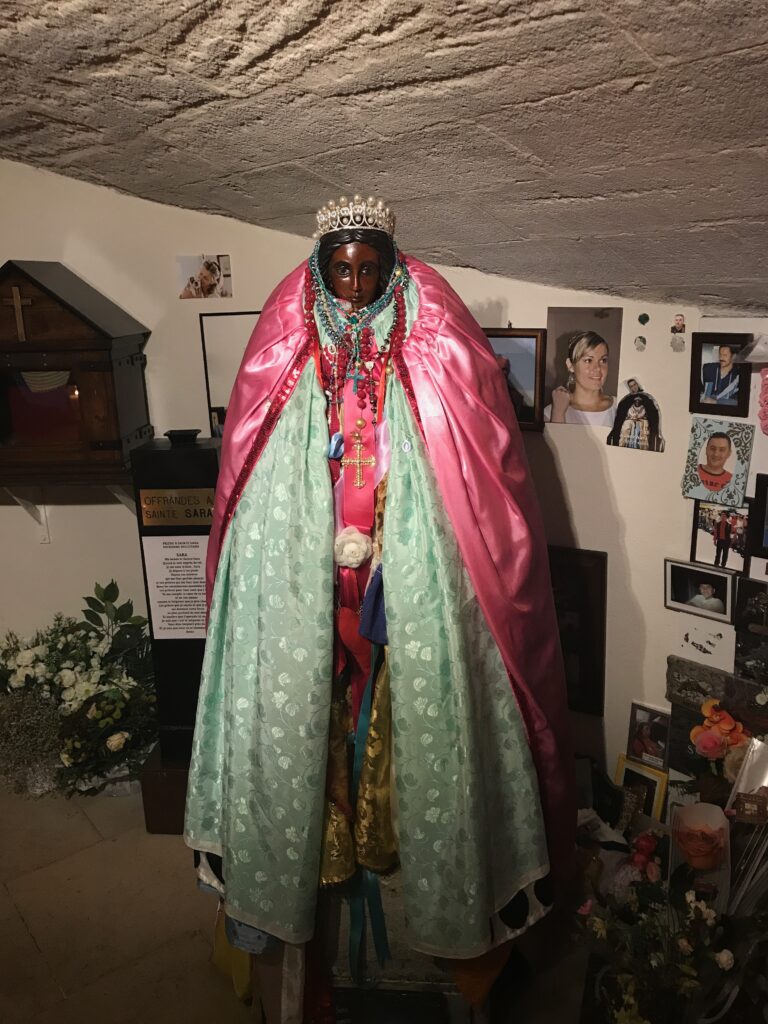
Legends abound as to who the dark Sara was. Some say she was an Egyptian servant to the Jewish Marys who arrived by boat, some say she was a local Romani girl and a spirit keeper of feminine traditions, and some suggest she was the daughter of Mary Magdalene and Jesus. Her statue is one of the many Black Madonnas in the region, and is solemnly carried out into the sea by Roma people on her feast day of May 25th, in a ceremony vaguely reminiscent of a holy bath in Ganga river.
In 1448, René d’Anjou, who had a passionate devotion to Mary Magdalene (and was also a friend, and some say even a lover, of Joan of Arc — but more on that later) got papal consent to excavate the old 6th century chapel in Saintes Maries. He found pottery with Christian symbols on it and, in December 1448, two skeletons, which he declared to be those of Mary Jacobi and Mary Salomé.
Romani pilgrimages began the following year, 1449, and have continued ever since, from all over the world. Sara la Kali, or Sara the Black, is inevitably associated with the goddess Kali, the destructive force of the Divine Feminine. Indeed, the church of Saintes Maries has an image of Kali in a glass cabinet. But the Roma people themselves vehemently deny any form of Kali-worship, saying that kali, in both Sanskrit and in Romani, simply means “dark”.
Arles
Only some 30 minutes drive from Saintes Maries is Arles, an ancient port, and a center of goddess worship in pre-Christian times. It was a cosmopolitan city closely linked to Alexandria in Egypt. The museum of antiquities in Arles hosts a remarkably well-preserved boat from around AD 40, used for navigating the river Rhône.
For me personally this ship had something of a “Galilee boat” flavor, reminiscent of a 2000-year-old wooden boat from the Sea of Galilee. There is a thought sneaking in, imagine that Mary Magdalene could have sailed that!

The town itself is still dominated by it Roman amphitheater, which was inspired by the Colosseum in Rome. It is now a relaxed small town with friendly locals and beautiful gardens. Arles, with its soft light, was home to many famous artists, including Van Gogh, Pablo Picasso and Paul Gauguin. The well-known Gipsy Kings are also from Arles. Their music is a mixture of Catalan, Andalusian and Provençal influences, which is only representative of this part of the world.
Sainte Baume
According to legends, Mary Magdalene left what is now Saintes Maries de la Mer in Camargue and went to Marseilles. Eventually, she moved to a inland and settled in the holy cave of Sainte Baume to lead a quiet life of contemplation. There, she spent the last 30 years of her life as an hermit. The cave is said to have been a center of Isis worship around the time of her arrival.
In a spectacular setting at the foot of the mountains, Sainte Baume now hosts a small monastic hotel for pilgrims (with superior food!), a tavern and a souvenir shop.
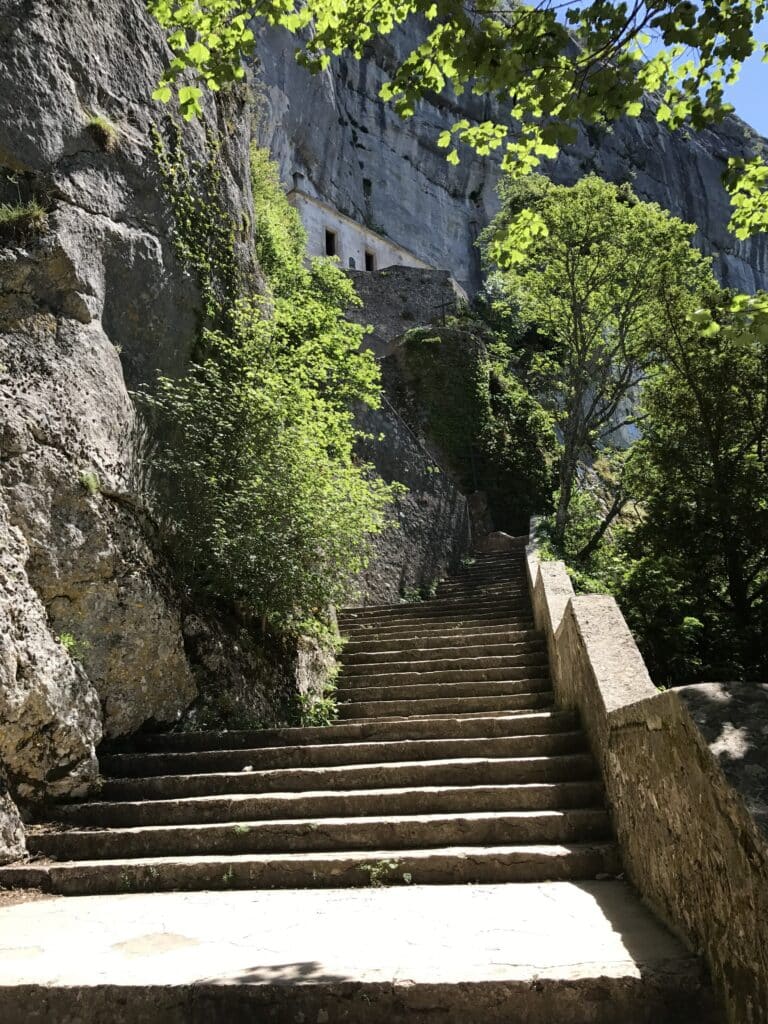
Some of these legends seem an adaptation of the story of St Mary of Egypt, a prostitute who at one point could not enter the church of the Holy Sepulcher in Jerusalem, eventually repented and ended up spending 30 years in the Judean desert. She lived there, covered only with her hair and subsisting only on food the angels brought her. We may never know for certain whether Mary Magdalene really lived in the cold and humid cave in the mountains, but her spirit is certainly very present there now.
The walk up to the cave takes about 45 minutes — a strenuous, but not impossible, hike through an ancient sacred forest. The pilgrims to the grotto form a motley crowd of hikers, spiritual explorers, Charismatic Catholics, school groups and local devotees. Everyone is encouraged to spend time in silence as they walk the inner path of their own conversion to Love.

It was an ancestor of Rene d’Anjou, King Charles II, who discovered the tomb of Mary Magdalene in nearby St Maximin in 1279. Rene himself visited the Grotto as a pilgrim, and even requested papal support to reconstruct some of the local buildings damaged in the fire in the 1440s. Rene first met Joan of Arc in 1428, and later fought alongside her, while his mother financed her military campaign.
There is some speculation that Joan of Arc and Rene were close friends, maybe lovers, or that they belonged to the same underground current of belief and practice. The same current that we witnessed in Vezelay, and that somehow always has Mary Magdalene at its root.

Mary Magdalene would occasionally be taken up by angels to the top of the mountain, in the rapture of Mystical Union with her Beloved Jesus. This place of Union is commemorated by the chapel of Saint-Pilon, a further half-hour climb on a considerably more challenging terrain (still doable without angelic intervention).
The views, and the energy on top of the Sainte Baume massif are unparalleled. The place has an ecstatic, rapturous energy. It is common to pray in tongues, sing, or otherwise behave somewhat “out of place” (as one realizes after descending back to the monastery).
The chapel that commemorates Mary Magdalene’s own rapture is devoid of Christian symbols — there are no crucifixes, crosses, or founts of holy water, no icons or images of Jesus, no Bibles, no apostles. Just Mary, like a Greek goddess, naked, ascending into heaven towards the Beloved…
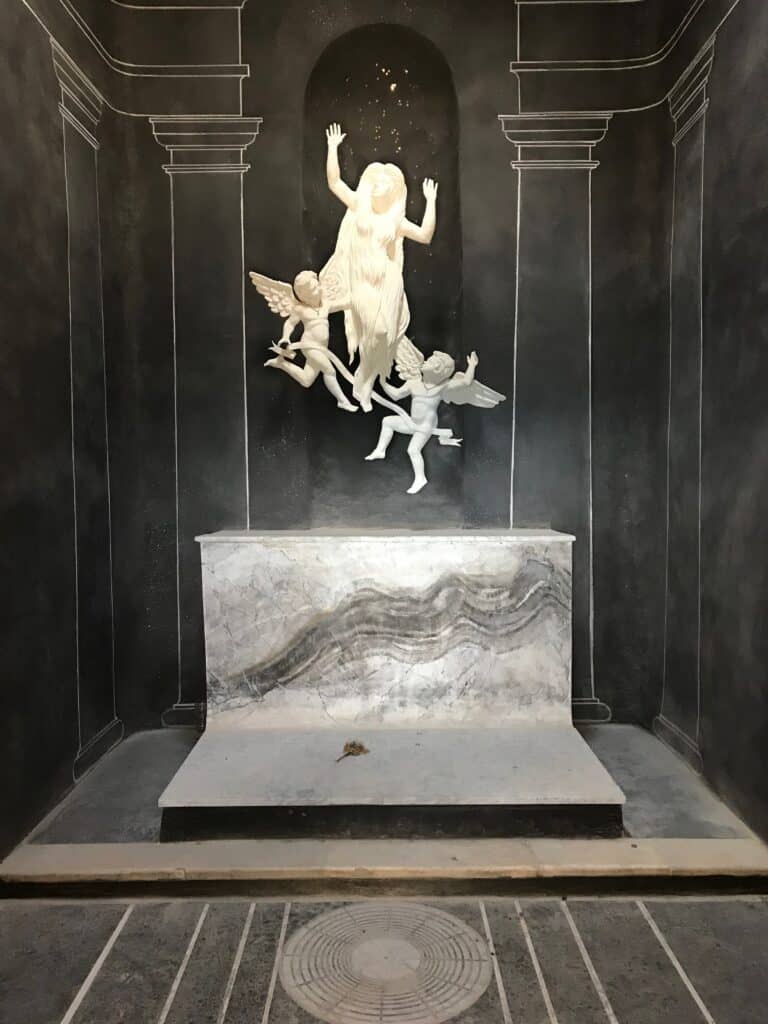
Among the many colorful characters who visit Sainte Baume, I met a local who walks up with a pilgrim’s staff to visit Mary Magdalene every year. The walk takes him 9 hours from his home town in Provence. A very well educated man, he has found this short pilgrimage to be the most beneficial for clearing the mind and soul.
We would all share a meal together in the monastery, a teacher who claimed to channel Venusians and held initiations in a vulva-shaped cave in the woods, Charismatic Catholics with their blessed salt, heretics, contemplatives, monks, atheists, healers and charlatans, liberals and conservatives, men and women — all brought together by a longing to take part in the sacred mystery of the Way of Love.
Vézelay

Home to the magnificent Romanesque Basilica of Saint Mary Magdalene, Vezelay deserves a whole book, rather than just a passing mention in a blog post. Frequented by poets and writers, pilgrims and seekers, the place where Bernard of Clairvaux preached the second crusade, where Richard the Lionheart set off for the third, with a rich Templar and Masonic heritage — this little village is a hidden treasure.
The present building of the basilica was dedicated in April 1104. The master builders of the church were perfectly aware of sacred geometry, the arrangement of the planets and the position of the Sun at solstice and equinox. At noon on the summer solstice, the sun shines down the center of the nave with mathematical precision. The builders also made sure to align with the waterways and electromagnetic energy lines underneath the church. The lines intersect at a point in the crypt that holds the relics of Mary Magdalene.

The most remarkable thing about Vezelay is its unmistakable Templar and Masonic heritage. Just outside the cathedral, the bookshops sell statues of Isis, Ma’at and Hathor, esoteric guides to France, books on alchemy, Cathars and the Templars.
But the Divine Feminine found her way inside the church, as well. Below is the picture of the monstrance in the shape of Ankh, the ancient Egyptian symbol of goddess Isis (associated with the life-giving power of the womb). While Ankh has been adopted by Egyptian Christians as the Coptic cross, its original meaning is the life-giving Union of the masculine and the feminine.
In the Catholic church, the Body of Christ is considered to be physically, and metaphysically, present during the sacrament of communion. A sun-shaped container, called the monstrance is used by Catholics to display the sacramental Host, the body of Christ, for adoration. This golden sun symbolizes Christ as the Sun of Righteousness. In Vezelay, however, things are somewhat different…

When I went up to finally sit for adoration and witness with my own eyes the Holy Host in the Ankh-shaped “monstrance,” I was only able to have about 5 minutes of wonder. A funeral Mass had started, and me and a couple of nuns had to leave. Our Lady of the Underworld always has a strange sense of humor…
Domremy
In my travels, I find it impossible to avoid Domremy-la-Pucelle, a tiny village in Lorraine that doesn’t even have a grocery store, surrounded by fields and sheep pastures, famous for one thing — this is where Joan of Arc grew up.
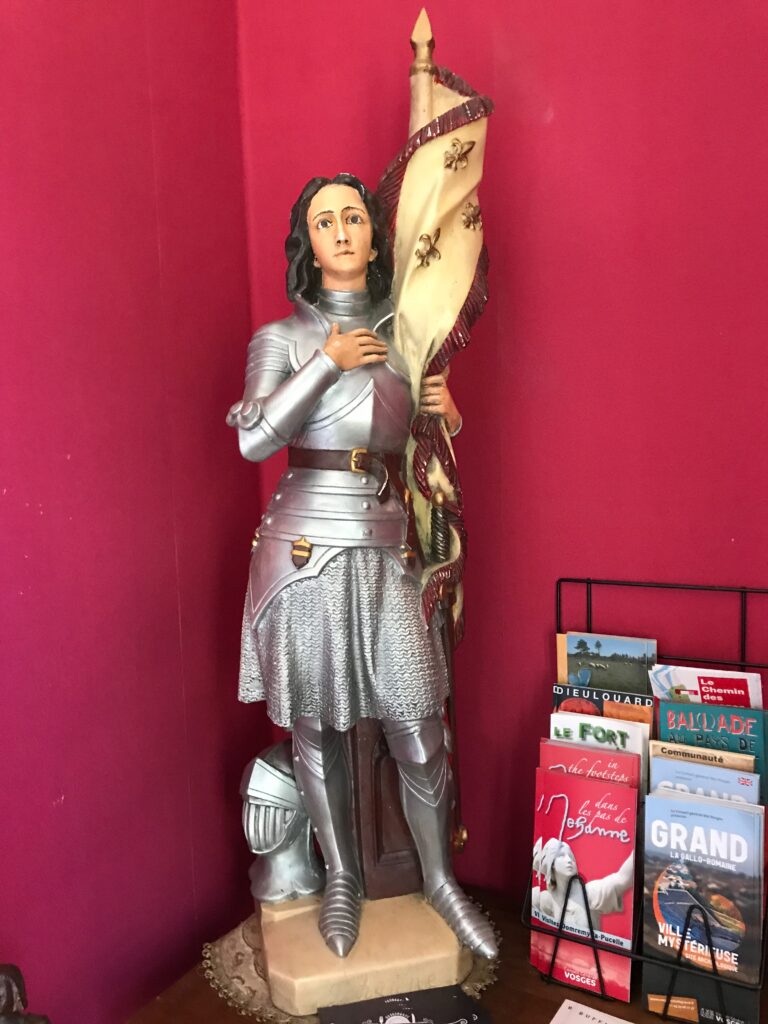
The village, a cite of an ancient Celtic settlement and the worship of Sacred Feminine, hosts a home where Joan of Arc had — reportedly — grown up, and a beautiful basilica 2 kilometers away in the fields near the “Fairy tree” where she first received her call. Domremy is located on a line linking to Chartres, and passing through several Celtic sites, including Sion-Vaudémont, the site of the actual Priory of Sion, whose founder may have been Rene d’Anjou.
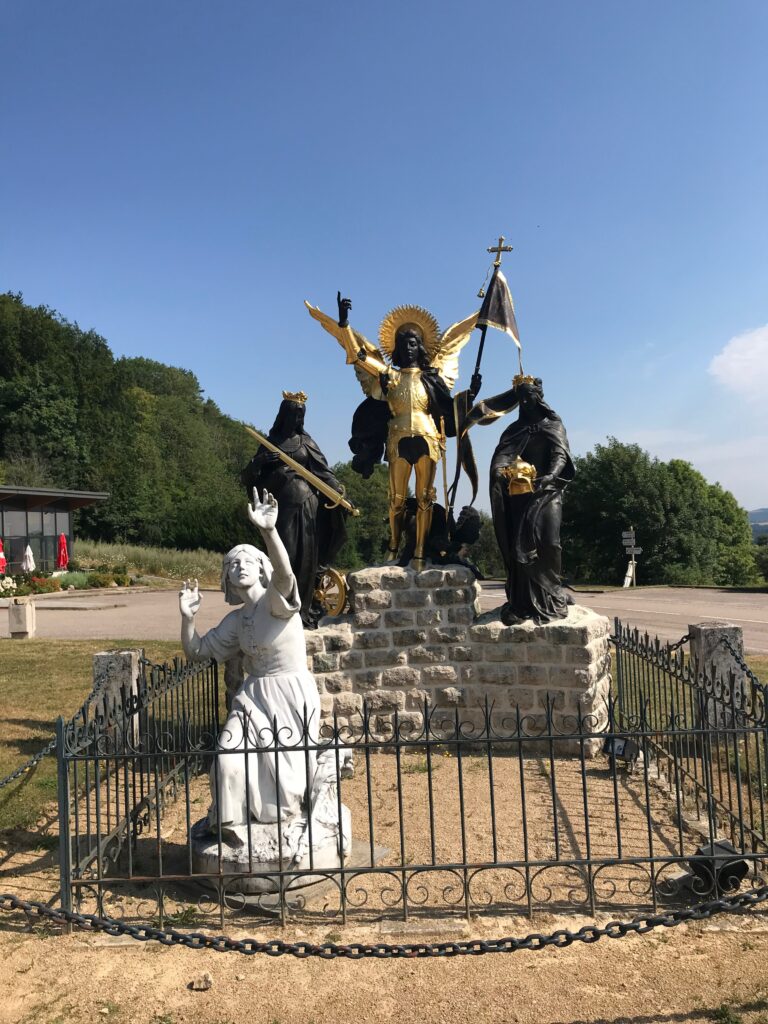
Some researchers that I met in Domremy claim Joan of Arc was an illegitimate daughter of Isabeau of Bavaria, the Queen of France, married to a mentally ill king (their son was the Dauphin whom Joan helped crown). This would make Joan considerably older than her alleged age.
French genealogy aside, Joan of Arc has a very practical, no-nonsense energy about her. A woman who was the Commander-in-Chief of her country’s army, she has a very concise message to those of us who were raised to please, agree, or follow the crowd — go! There is ultimately no other option but to follow the still small voice within, no matter how crazy, unsafe or counter-current it seems.
And I can only conclude with a heartfelt, go! Go and visit this sacred land for yourself. Be renewed, surprised and struck with awe. Eat, drink and celebrate, meet the people over long and hearty lunches. Language barrier is never an obstacle when you connect heart to heart. Go.


I absolutely loved it!
Thank you so much for sharing it!